Tiger
Panthera Tigris
The largest feline in the world!
Advertisement
Tiger Scientific Classification
- Kingdom
- Animalia
- Phylum
- Chordata
- Class
- Mammalia
- Order
- Carnivora
- Family
- Felidae
- Genus
- Panthera
- Scientific Name
- Panthera Tigris
Read our Complete Guide to Classification of Animals.
Tiger Conservation Status
Tiger Facts
- Main Prey
- Deer, Cattle, Wild Boar
- Habitat
- Dense tropical forest
- Predators
- Human
- Diet
- Carnivore
- Average Litter Size
- 3
“No two tigers share the same pattern of stripes.”
Tigers are animals that live in both warm and cold areas of Asia. They are carnivores that hunt for prey at night. These big cats are solitary, and territorial, and are one of the world’s apex predators. A Siberian tiger can weigh up to 675 pounds. Males are bigger than females.
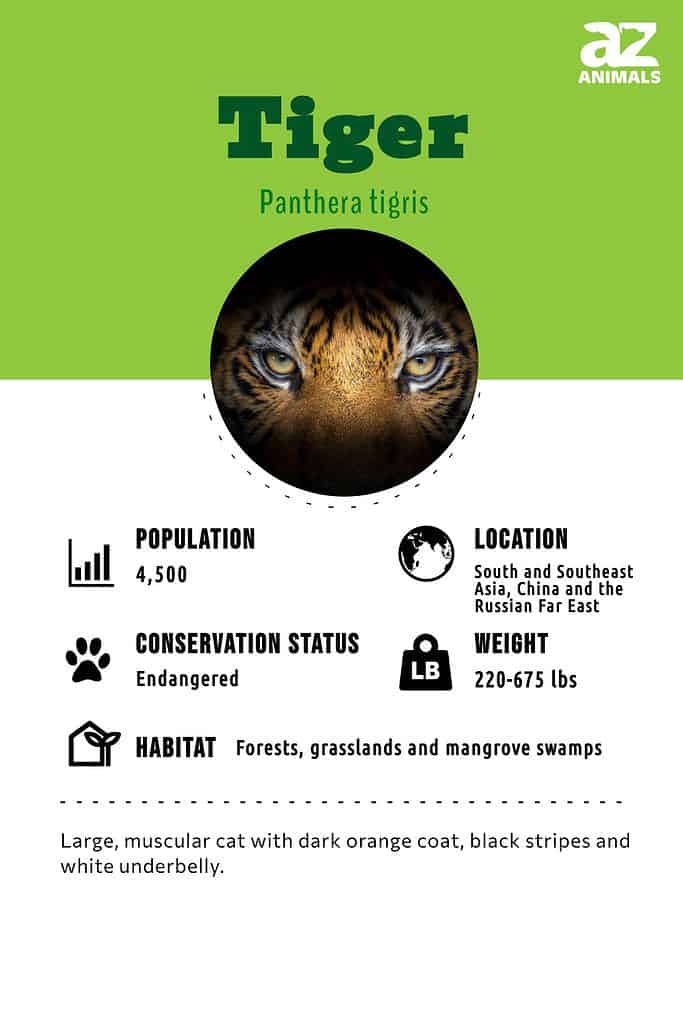
5 Incredible Tiger Facts!
- Tigers are good swimmers and love the water.
- They are hunted for their skin, fur, and other body parts.
- They mark their territory with urine to keep other tigers out.
- Their teeth measure about 4 inches long.
- This creature’s long tail helps it to keep its balance.
Scientific Name
The scientific name of the tiger is Panthera tigris. The word Panthera means leopard and Tigris is Latin for tiger. They are sometimes called big cats. They belong to the Felidae family and the Mammalia class.
Nine subspecies include Sumatran, Siberian, Bengal, South China, Malayan, Indo-Chinese, Bali, Javan, and the Caspian tiger. Unfortunately, the Bali, Javan, and Caspian species are now under extinct classification.
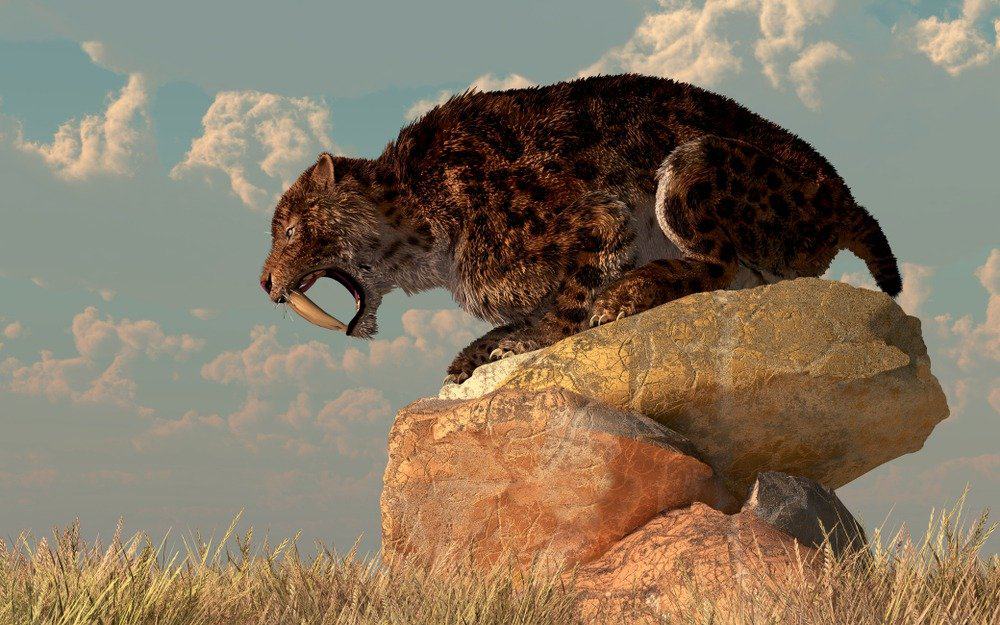
Around 1.6 million years ago, the saber-tooth tiger,
Smilodon,
was found in fossil records discovered in the La Brea tar pits in California.
©Daniel Eskridge/Shutterstock.com
Evolution
When thinking about the exotic animals of Africa – most would name the tiger among the big cats that hunt on the continent’s plains and savannahs. While the tiger did evolve from those majestic cats of Africa – the modern tiger has never lived there. As a matter of fact, tigers are less related to lions and leopards and more related to the endangered snow leopard.
The first mammals are believed to have lived 208 million years ago – after the extinction of dinosaurs. The first carnivores came from animals known as miacoids about 60 million years ago. These tree dwellers were about the size of a domestic cat and had developed sharp crushing teeth. Miacoids are the oldest relative to the modern-day tiger.
Carnivores split into two groups – Carniformia and Feliformia – around 40 million years ago. The Carniformia group was more bear-like and evolved into bears, dogs, weasels, raccoons, skunks, badgers, sea lions, walruses, and seals. Feliformia was more cat-like and evolved into cats, hyenas, and mongooses.
Proailurus, the oldest cat, appeared in France 30 million years ago. This aboreal creature weighed around 25 pounds and had eight more teeth than modern cats. 20 Million years ago, the direct ancestor of modern cats, Pseudaelurines, was found in the fossil record. Around 1.6 million years ago, the saber-tooth tiger, Smilodon, was found in fossil records discovered in the La Brea tar pits in California. These big cats became extinct around 10,000 years ago.

A tiger’s pattern of stripes is as unique to the individual as fingerprints are to humans.
©iStock.com/Ondrej Prosicky
Appearance and Behavior
A tiger has a heavy coat of reddish-orange hair featuring a pattern of black stripes. Each has its own pattern of stripes kind of like a human’s fingerprints. It has a long tail as well as sharp teeth and claws. Its body measures 5 to 10.5 feet long and can weigh from 240 to 675 pounds, depending on the subspecies. For example, a 6-foot tiger is equal in length to a full-size bed. One weighs 500 pounds and is half the weight of a grand piano!
The largest tiger ever weighed more than 800 pounds while the largest subspecies of tiger is the Siberian, which has an average weight that reaches up to 675 pounds!
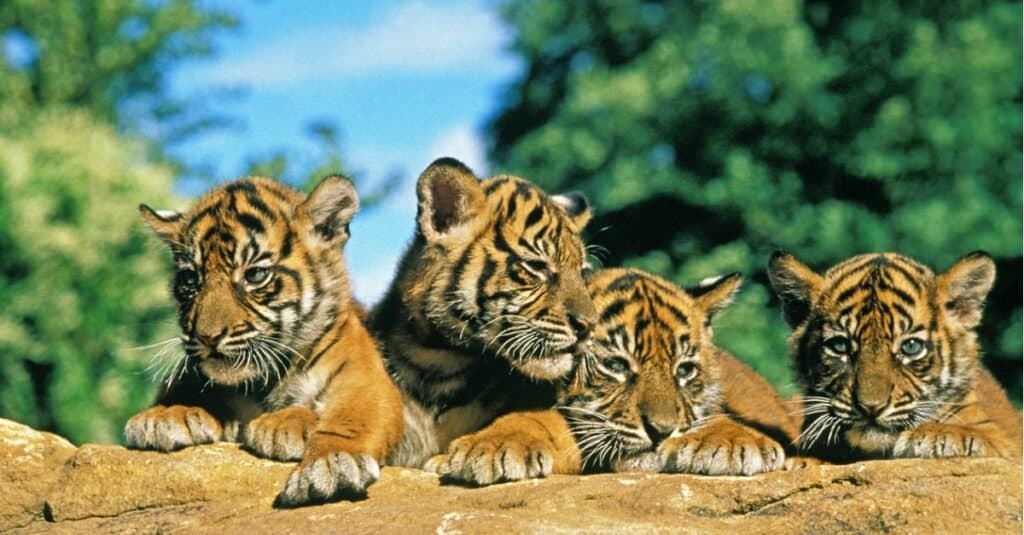
Tigers are solitary except when females are raising their cubs.
©iStock.com/slowmotiongli
This cat’s striped tail measures about 3 feet long. This is equal to the length of three wooden rulers lined up end to end. It uses its tail to maintain balance when making quick turns as it runs after prey. It uses its 4-inch claws to grab onto prey. In addition, its paws allow it to walk quietly while stalking its next meal. Also, they have webbed feet making them excellent swimmers if they have to cross a river, stream, or other body of water in search of prey.
Adult tigers are animals with very few predators. Humans are the main predators of these cats. But they are also vulnerable to elephants and large buffalos due to the extraordinary strength and size of these mammals. These big cats’ speed, claws, and teeth are all defensive features.
These are solitary animals. The only exception is when females are raising their cubs. On the rare occasions these big cats are seen in a group, the group is called an ambush. These big cats try to stay out of sight of humans and other animals but can be aggressive if their territory is invaded.

The Siberian tiger is the largest subspecies at 10.5 feet long and up to 675 pounds.
©Jan Stria/Shutterstock.com
Types of Tigers
When considering the nine subspecies, the Siberian tiger is the largest of the group. It grows to be 10.5 feet long or longer. It’s also the heaviest, weighing in at 675 pounds. The SumSumatran Tigeratran tiger is known as the smallest classification of the species weighing around 260 pounds and growing to be about 8 feet long.
Though the nine subspecies appear to have the same coloration, there are some differences. For instance, the Sumatran is the one with the darkest fur with its stripes placed close together. Some species have a lot of stripes on their legs while others have very few.
The BenBengal Tigergal is the most plentiful of all the subspecies. Most have the familiar reddish-orange coat with black stripes. Interestingly, some Bengals and Siberian tigers have a recessive gene that causes them to have coat site coats with black stripes. Cats with this white and black fur coat are not usually found in the wild.
South China Tigers are categorized as Critically Endangered. Their population is unknown. Unfortunately, the government declared them pests at one time and they were hunted causing their numbers to decrease drastically.
The Malayan tiger lives in a tropical climate. More specifically, they live in forests with broadleaf trees in Thailand. Their population has decreased, and they are considered Endangered.
The Indo-Chinese tiger lives in Cambodia, Thailand, and Vietnam. This subspecies has a coat that is darker than that of the Bengal tiger and they are smaller in size than Bengals. They live in mountainous habitats. Their population is unknown because they live in such remote places.
The Bali, Javan, and Caspian tigers are now extinct. This is due to poaching activity as well as loss of habitat.

Tigers live in different habitats
including swamps, grasslands, and deciduous and mangrove forests.
©iStock.com/ANDREYGUDKOV
Habitat
Tigers live in South and Southeast Asia as well as the eastern part of Russia and China. Some live in temperate climates while others live in tropical environments. Siberian tigers live in cold climates where it snows. Their heavy fur coat and an extra layer of fur on their paws protect them from cold temperatures. Also, they have an extra layer of fur around their neck that’s sometimes called a scarf. This insulates them from the cold even more.
Tigers live in different habitats including swamps, grasslands, and deciduous and mangrove forests. The type of habitat each of the subspecies lives in depends on its species.
Malayans live in tropical broadleaf forests while Indo-Chinese tigers live in hilly, mountainous areas. Bengals live in rainforests while the Sumatran live in lowland forests and around swamps.
Tigers sometimes migrate short distances in order to find a larger supply of prey. Also, they may migrate to an area with less snow and warmer temperatures in the cold weather months.

Diet
What does a tiger eat? With powerful jaws, claws, and superb hunting abilities -tigers are carnivores who eat pretty much anything they want. Deer, antelope, buffalo, and pigs are some of the prey of tigers. Tigers have even been known to eat leopards and crocodiles!
Tigers use their stalking skills, speed, and quick movements to take down their prey. However, these big cats usually eat just once per week. They are capable of eating 75 pounds of meat in one evening. Seventy-five pounds is equal to four adult dachshunds. Tigers have a habit of killing prey, eating as much as they want, then covering the rest of it with leaves so they can come back later for a snack. For a complete list of the foods tigers eats, check out our “What Do Tigers Eat?” page.
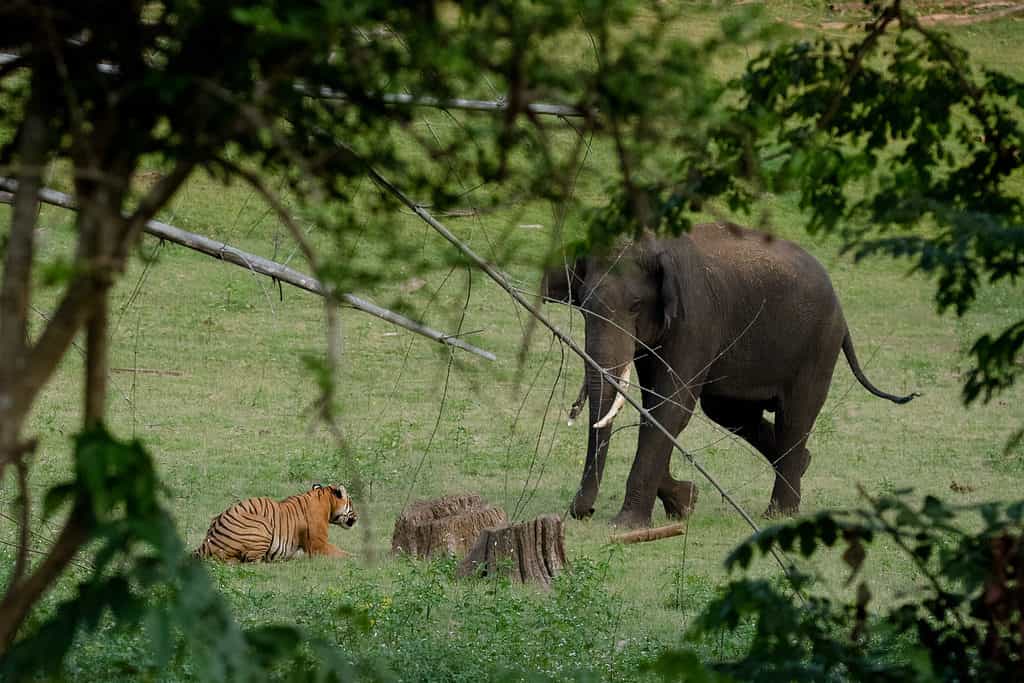
While humans are the main predators of tigers, they are also vulnerable to
elephants
and large buffalos.
©Wildberry India/Shutterstock.com
Predators and Threats
Because of their size and strength, adult tigers don’t have many predators. Humans are predators of this animal. Elephants and bears can also pose a threat to them. Tiger cubs have a lot more predators than adults – including hyenas, crocodiles, and snakes.
Habitat loss through deforestation is a threat. Poaching is another major threat. They are hunted for their skin, fur, teeth, and other body parts. Also, many are captured and sold to individuals as exotic animals. This is illegal. These creatures do not receive the proper care when sold as exotic pets. In many cases, they are starved by their owners and not given the proper medical care, shelter, or exercise. Not surprisingly, tigers kept as exotic pets have been known to attack and injure or kill the people who purchased them.
Of course, a tiger living in a zoo environment receives the proper care from veterinarians and others who are trained to care for them in the best possible way.
The conservation status of the tiger is Endangered with a decreasing population. Fortunately, they are now protected by the Convention of International Trade in Endangered Species of Wild Fauna and Flora (CITES).
Reproduction, Babies, and Lifespan
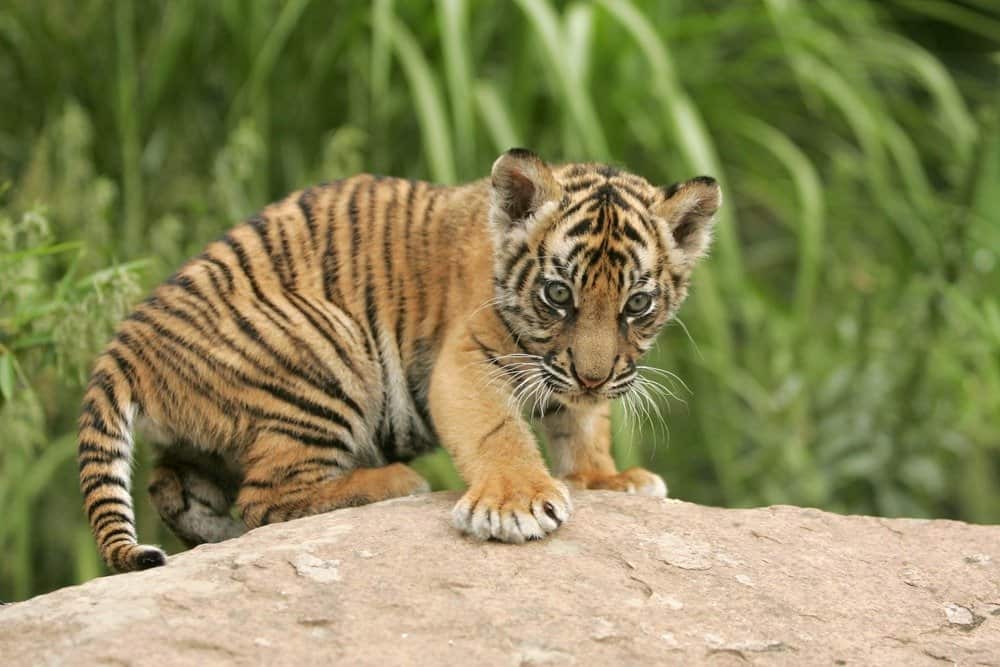
Tiger cubs weigh from 2 – 3 pounds at birth.
©Bildagentur Zoonar GmbH/Shutterstock.com
The breeding season of this creature usually falls between November and April. However, they can breed at any time of the year. A female that’s ready to mate marks her territory with a particular scent. This attracts males to the area. The males sometimes fight and otherwise compete for a female that is ready to mate. Tigers are not monogamous; they mate with different partners each breeding season.
The gestation period is around 100 days. A litter can number from 1 to 7 cubs, but usually, a female gives live birth to 2 to 4 cubs. Each tiger baby, or cub, weighs from 2 to 3 pounds at birth. Like other cats, tiger cubs are born blind. Their eyes open in 6 to 12 days. These newborns rely on their mothers for everything.
They are cared for by their mother and nursed for the first 6 weeks of life. The mothers are very protective of their cubs. Young cubs are vulnerable to a variety of predators and many fall victim to them before they are strong enough to defend themselves. So, if a mother feels her cubs are threatened in any way, she moves them to another den one baby at a time. Plus, she only leaves them for brief amounts of time to hunt for food. She licks each baby in an effort to clean its fur and stimulate its digestive system.
At 7 weeks old, the cubs are fed solid food by their mother. She brings food to the den and breaks it up for the cubs. The cubs spend a lot of time wrestling and chasing one another as a way to strengthen their muscles and learn stalking behaviors. At eight to 10 months, the cubs are ready to go out and hunt with their mother. They stay with her until they are around 2 years old.
Tigers suffer from some of the same threats/ailments as other types of cats. Feline leukemia, rabies and anemia are some examples.
They live from 10 to 15 years in the wild. In zoos, they can live up to 20 years or more. The world’s oldest tiger was a Sumatran named Djelita. She lived at Honolulu Zoo and reached the age of 25 years old.

The South China Tiger population is unknown because of the remote, mountainous area where they live.
Population
Bengals are the most plentiful of all the tiger species. Bengals living in India numbered between 2,500 and 3,750. As for the other subspecies, according to the IUCN Red List, there are 2,154 to 3,159 mature individuals in existence. The population of some tigers such as the South China tiger is unknown because of the remote, mountainous area where they live.
The official conservation status of the tiger is Endangered with a decreasing population.

Tiger leans up against the cage while being fed from the other side.
©Pierre Aden/Shutterstock.com
In the Zoo
- See the beautiful Malayan tigers at the Cincinnati Zoo.
- Check out the Tiger Trail at the San Diego Zoo.
- Admire the Siberian tigers at Indianapolis Zoo.
More on Tigers
View all 133 animals that start with TTiger FAQs (Frequently Asked Questions)
Are tigers omnivores, herbivores, or carnivores?
Tigers are carnivores eating deer, antelope, and boars as well as monkeys, snakes, and sloth bears.
How long do tigers live?
The lifespan of a tiger is 10 to 15 years. But they can live to be 20 years old or more in captivity.
Which is the rarest tiger?
The classification of the rarest tiger in the world goes to the South China tiger.
How many kinds of tigers are there?
There are 9 subspecies of tiger, but 3 of those are now extinct. They all go by the scientific name Panthera tigris.
Where do white tigers live?
Bengal and Siberian tigers with a recessive gene have white fur instead of the familiar reddish-orange coat with black stripes. Bengal tigers live in India in grasslands and tropical rainforests. Siberian tigers live in the forests of Russia. These forests provide them with shelter from the elements and keep them hidden.
What is the biggest tiger?
The biggest tiger is the Siberian. An adult male can grow to be 10 feet long and weigh up to 660 pounds or more.
What Kingdom do Tigers belong to?
Tigers belong to the Kingdom Animalia.
What class do Tigers belong to?
Tigers belong to the class Mammalia.
What phylum to Tigers belong to?
Tigers belong to the phylum Chordata.
What family do Tigers belong to?
Tigers belong to the family Felidae.
What order do Tigers belong to?
Tigers belong to the order Carnivora.
What type of covering do Tigers have?
Tigers are covered in Fur.
What genus do Tigers belong to?
Tigers belong to the genus Panthera.
What is the main prey for Tigers?
Tigers prey on deer, cattle, and wild boar.
What are some predators of Tigers?
Predators of Tigers include humans.
How many babies do Tigers have?
The average number of babies a Tiger has is 3.
What is an interesting fact about Tigers?
Tigers are the largest feline in the world!
What is the scientific name for the Tiger?
The scientific name for the Tiger is Panthera Tigris.
How fast is a Tiger?
A Tiger can travel at speeds of up to 60 miles per hour.
What is the difference between a liger and a tiger?
The main differences between ligers and tigers include their size, weight, appearance, behavior, roar distance, and lifespan. Ligers are born from a hybrid of a lion and a tiger, thus their similar appearance with tigers. Like tigers, ligers also belong to the genus Panthera which encompasses all spotted wild cats that have specific anatomical structures that help them roar.
Who would win a fight between a Komodo dragon and a tiger?
A tiger would win a fight against a Komodo dragon. An ambush by the tiger would instantly end a fight against a Komodo dragon, and the tiger would just as easily win a battle without the element of surprise. In fact, if it was attacked from hiding by the Komodo dragon, which is not likely, then it would turn the tables on the smaller, weaker animal.
Who would win in a fight between a tiger and a sloth bear?
A battle pitting a tiger vs. a sloth bear isn’t as far-fetched as it might sound After all, they both live across India. Also, while sloth bears share a name with one of the slowest animals on earth, they’re actually fairly dangerous animals that have hundreds of altercations with humans per year. However, in a battle between a tiger and sloth bear, it’s likely the tiger would come out on top and is more adapted to being an apex predator while sloth bears mostly feed on termites.
Who would win a fight between a tiger and an alligator?
A tiger would win a fight against an alligator.
However, this ruling comes with a few caveats. If a hungry tiger decides to attack an alligator on land, the alligator would have no chance.
Who would win the fight between a tiger and a leopard?
In the battle of leopard vs tiger, the tiger would win. Tigers often prey on leopards to take their kill or in defense of their territory.
Who has bigger claws between an eagle and a tiger?
Harpy eagles have claws as long as 5 inches, which are bigger than a typical tiger’s claws which grow up to 4 inches in length.
How to say Tiger in ...
Thank you for reading! Have some feedback for us? Contact the AZ Animals editorial team.
Sources
- Sea World, Available here: https://seaworld.org/animals/all-about/tiger/characteristics/
- National Zoo, Available here: https://nationalzoo.si.edu/animals/tiger
- Live Science (1970) https://www.livescience.com/29822-tiger-subspecies-images.html Jump to top

















